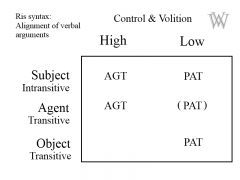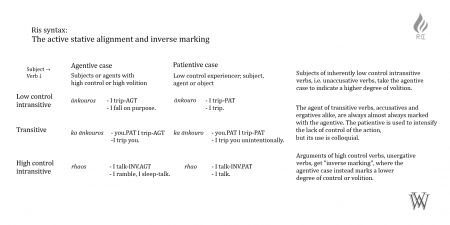User:Waahlis/Sandbox/Ris: Difference between revisions
(Created page with "==Morphosyntactic alignment and the core cases== [[Image:Control-argument-qri.png|right|thumb|A table of the Ris control and volition distinction in the core arguments, illust...") |
(No difference)
|
Revision as of 19:56, 18 July 2013
Morphosyntactic alignment and the core cases
Ris possess an originally active-stative alignment, which means that the two arguments of transitive verbs, the subject and object, are marked with the agentive case and patientive case respectively. The agent of an intransitive verb, however, can be marked with either. The agentive and patientive cases denote a different degree of control and volition with the arguments. Depending on the intransitive verb, different cases would be used.
It later developed the so-called fluid-S subtype, which infers that any intransitive verb can use both the patientive and agentive cases, wich each grant a different degree of control of the verb.
Patientive case
The patientive, or undergoing case, (pat) is the case used to indicate both the subject of an intransitive verb and the object of a transitive verb, in addition to being used for the citation form of nouns.
The patientive is used on low control agents, and experiencers of actions - neither of which have much influence on the verb. Colloquially, the patientive can be used on agents of transitive verbs to indicate a degree of innocence, lack of control of the event.
- Ānkouro.
/ˈaːŋkʊrɔ/
ānkour-o
to trip.ACT.IND.PRFV-PAT.1.SG
I fell.
- Sausani hentai inistin.
/ˈsawsanɪ ˈçɛntaj ˈɪnɪstɪn/
sausa-ni in-ist-in
pig.III-PAT.DC okay.ADJ.PAT to exist-ACT.IND.IPFV-3.PAT.DC
Okay squirrel soups exist.
- Tagērras kērax.
/ˈtageːrras ˈkeːraks/
tagēr-r-as kērax-∅
to hit-ACT.IMP.PRFV-2.SG.AGT bird.I-PAT.SG
Hit the bird.
- Anēr, ouinēstra teskho...
/ˈaːŋkʊrɔ/
anēr-∅ ouinēstra-∅ teskh-o
mother.I-VOC.SG window.II-PAT.SG to smash.ACT.IND.PRFV-PAT.1.SG
Mother, I happened to smash the window...
Agentive case
The agentative (agt) case is used to mark the subject, or agent, of transitive verbs. The agentive marks high control, volitional agents of verbs.
- Mau katēro kterma.
/maw kaˈteːrɔ ˈktɛrma/
mau katēr-∅-o kterma-∅
1.AGT.SG to write-ACT.IND.PRFV-IN.PAT.1.SG letter.III-PAT.SG
I am writing a letter.
- He tethoūris.
/ˈhɛ tɛˈtʰʊːrɪ/
he te~thoūr-is
2.AGT.SG ACT.IND.ITR~to run-1.AGT.SG
He is running around.
- Ānkouros...!
/ˈaːŋkʊros/
ānkour-∅-os
to trip.ACT.IND.PRFV-AGT.1.SG
I purposely trip...!
Inverse marking: Unergatives and unaccusatives
To be continued.

